Deterioration of Exhaust Emissions in Ageing Gasoline Vehicles Assessed by RDE Testing
Abstract
1. Introduction
2. The Issue of Changes in Vehicle Emissions During Their Service Life
3. Research Problem and Method
4. Research Experiment
5. Analysis of Working Conditions and Operational Test Results
6. Conclusions
- the change in carbon dioxide emissions (and thus fuel consumption) during the entire operational test increased by approximately 10% (the largest increase of 8% occurred after the test at 85,000 km); the subsequent increase was not as significant;
- the change in road carbon monoxide emissions was linear up to a mileage of approximately 120,000 km, and in this test, it was more than 90% higher than in the test at 18,000 km; in the latest test, it increased by less than 5%;
- the change in road nitrogen oxide emissions was the greatest of all exhaust components tested during the petrol vehicle’s road tests; after approx. 100,000 km, there was an increase of approx. 50–60%, and a subsequent test after 165,000 km revealed an increase in NOx emissions of approximately 150% compared to the first test.
- For diesel-powered vehicles [20], NOx emissions in the RDE tests performed were 70% higher for vehicles with mileage higher than 86,000 km. CO emissions were 23% higher for vehicles with mileage higher than 86,000 km, while CO2 emissions were 19% higher for vehicles with mileage higher than 86,000 km.
- For petrol-powered vehicles, NOx emissions in the RDE tests were approximately 35% higher for a mileage of 85,000 km. CO emissions were 43% higher for a mileage of 85,000 km, while CO2 emissions were approximately 8% higher for a mileage of 85,000 km.
Author Contributions
Funding
Data Availability Statement
Acknowledgments
Conflicts of Interest
Abbreviations
| AMA | Approved Mileage Accumulation |
| BEV | Battery Electric Vehicle |
| CLTC | China Light-Duty Test Cycle |
| CNG | compressed natural gas |
| CO | Carbon Monoxide |
| CO2 | Carbon Dioxide |
| CSRD | Corporate Sustainability Reporting Directive |
| DF | Dilution Factor |
| DPF | Diesel Particulate Filter |
| EPA | Environmental Protection Agency |
| ESG | Environmental, Social and corporate Governance |
| FID | Flame Ionisation Detector |
| GBDT | Gradient Boosting Decision Tree |
| HDV | Heavy-Duty Vehicle |
| HEV | Hybrid Electric Vehicle |
| ICE | Internal Combustion Engine |
| M | Motorway |
| NDIR | Non-Dispersive Infrared |
| NDUV | Non-Dispersive Ultraviolet |
| NMVOC | Non-Methane Volatile Organic Compound |
| NOx | Nitrogen Oxides |
| OBD | On-Board Diagnose |
| PHEV | Plug-in Hybrid Electric Vehicle |
| PM | Particulate Matter |
| PN | Particle Number |
| R | Rural |
| RDE | Real Driving Emissions |
| RPA | Relative positive acceleration |
| SHAP | Shapley Additive Explanations |
| SRC | Standard Road Cycle |
| U | Urban |
| US | United States |
| V | Velocity |
| V·a+ [95] | 95th percentile of the product of vehicle speed and positive acceleration |
| WLTC | Worldwide harmonised Light-duty Test Cycle |
References
- Eickenhorst, R.; Koch, T. An experimental study on aging effects of fuel-cut events including sound optimized torque reduction on modern three-way catalysts. Automot. Engine Technol. 2024, 9, 4. [Google Scholar] [CrossRef]
- Quarterly Report by PZPM and KPMG, Q2/2025, Automotive Industry. Available online: https://www.pzpm.org.pl/pl/Publikacje/Raporty (accessed on 1 September 2025).
- Balcerzyk, D. Rejestracje Samochodów Osobowych i Dostawczych w Sierpniu 2025 roku [Registrations of Passenger Cars and Light Commercial Vehicles in August 2025]. Available online: https://www.samar.pl/rynek-w-liczbach/rejestracje-nowych-samochodow-osobowych-i-dostawczych-2025-2025 (accessed on 1 September 2025).
- Automotive Industry Report, 2024/2025. Polish Automotive Industry Association. Available online: https://www.pzpm.org.pl/en/content/download/11094/68141/file/RAPORT_PZPM_07_12_2024_lekki.pdf (accessed on 3 September 2025).
- Emissions Distributions by Vehicle Age and Policy Implications. TRUE—The Real Urban Emissions Initiative, FIA Foundation, 2020. Available online: https://theicct.org/sites/default/files/publications/US-TRUE-emissions-distribution-oct2020.pdf (accessed on 22 September 2025).
- Corporate Sustainability Reporting, 2025. Available online: https://finance.ec.europa.eu/capital-markets-union-and-financial-markets/company-reporting-and-auditing/company-reporting/corporate-sustainability-reporting_en (accessed on 13 September 2025).
- Dornoff, J.; Rodríguez, F. Euro 7: The New Emission Standard for Light-and Heavy-Duty Vehicles in the European Union. 2024. Available online: https://theicct.org/wp-content/uploads/2024/03/ID-116-%E2%80%93-Euro-7-standard_final.pdf (accessed on 12 September 2025).
- Borken-Kleefeld, J.; Chen, Y. New emission deterioration rates for gasoline cars-Results from long-term measurements. Atmos. Environ. 2015, 101, 58–64. [Google Scholar] [CrossRef]
- Davison, J.; Bernard, Y.; Borken-Kleefeld, J.; Farren, N.; Hausberger, S.; Sjödin, Å.; Tate, J.; Vaughan, A.; Carslaw, D. Distance-based emission factors from vehicle emission remote sensing measurements. Sci. Total Environ. 2020, 739, 139688. [Google Scholar] [CrossRef] [PubMed]
- Mahesh, S.; McNabola, A.; Smith, W.; Timoney, D.; Ekhtiari, A.; Fowler, B.; Willis, P.; Rose, R.; Wareham, J.; Walker, H.; et al. On-road remote sensing of vehicles in Dublin: Measurement and emission factor estimation. Transp. Res. Part D Transp. Environ. 2023, 117, 103620. [Google Scholar] [CrossRef]
- Ntamwiza, J.M.V.; Ishimwe, N. Assessing the impact of vehicle characteristics on exhaust emissions in Rwanda: A study of gasoline engine vehicles amidst urbanization and transportation growth. Urban Plan. Transp. Res. 2025, 13, 1. [Google Scholar] [CrossRef]
- Wang, Y.; Xing, Z.; Zhang, H.; Wang, Y.; Du, K. On-road mileage-based emission factors of gaseous pollutants from bi-fuel taxi fleets in China: The influence of fuel type, vehicle speed, and accumulated mileage. Sci. Total Environ. 2022, 819, 151999. [Google Scholar] [CrossRef]
- Ligterink, N.E.; Kadijk, G.; Elstgeest, M.; van Mensch, P. Emission Compliance Over the Lifespan of a Vehicle. Research Group Sustainable Transport and Logistics. Available online: https://publications.tno.nl/publication/34634061/8uWBz9/ligterink-2019-emission.pdf (accessed on 9 September 2025).
- Wang, J.; Xu, Z.; Lu, W.; Ding, Y.; Wang, Y.; Hao, L.; Ge, Y. Emission durability of a China-6 light-duty gasoline vehicle. Sustainability 2024, 6, 7526. [Google Scholar] [CrossRef]
- Zardini, A.; Giechaskiel, B.; Martini, G. Durability Demonstration Programme for EURO6 Passenger Cars: Thermal Load to After-Treatment Systems; Final report, EUR 29278 EN; Publications Office of the European Union: Luxembourg, 2018. [Google Scholar] [CrossRef]
- Alves, C.A.; Lopes, D.J.; Calvo, A.I.; Evtyugina, M.; Rocha, S.; Nunes, T. Emissions from light-duty diesel and gasoline in-use vehicles measured on chassis dynamometer test cycles. Aerosol Air Qual. Res. 2015, 15, 99–116. [Google Scholar] [CrossRef]
- Wang, Y.; Hao, C.; Ge, Y.; Hao, L.; Tan, J.; Wang, X.; Zhang, P.; Wang, Y.; Tian, W.; Lin, Z.; et al. Fuel consumption and emission performance from light-duty conventional/hybrid-electric vehicles over different cycles and real driving tests. Fuel 2020, 278, 118340. [Google Scholar] [CrossRef]
- Targa, J.; Colina, M.; Banyuls, L.; González Ortiz, A.; Soares, J. Status Report of Air Quality in Europe for Year 2024, Using Validated and Up-to-Date Data (ETC-HE Report 2025/1). European Topic Centre on Human Health and the Environment, 2024. Available online: https://www.eionet.europa.eu/etcs/all-etc-reports (accessed on 6 September 2025).
- The Real World Emissions Driving Test: 2017 Fuel Economy and Emissions Report. Australian Automobile Association, ABMARC. 2017. Available online: https://www.aaa.asn.au/wp-content/uploads/2018/03/Real-World-Driving-Emissions-Test-Summary-Report.pdf (accessed on 11 September 2025).
- Pryciński, P.; Pielecha, J.; Korzeb, J.; Jachimowski, R.; Pielecha, P. Impact of vehicle aging and mileage on air pollution emissions. Energies 2025, 18, 939. [Google Scholar] [CrossRef]
- Sowa, T. Przebieg Samochodu a Jego Wiek-Czy Duża Liczba na Liczniku Musi Oznaczać, że Pojazd Jest Stary? [Car Mileage and Age-Does a High Number on the Odometer Necessarily Mean that the Vehicle is Old?]. Available online: https://mubi.pl/poradniki/przebieg-samochodu-a-jego-wiek/ (accessed on 2 September 2025).
- Varma, M.; Mal, H.; Pahurkar, R.; Swain, R. Comparative analysis of greenhouse gases emission in conventional vehicles and electric vehicles. Int. J. Adv. Sci. Technol. 2020, 29, 689–695. [Google Scholar]
- Czarnecki, P. Ile Wytrzymuje Bateria w Samochodzie Elektrycznym? [How Long Does the an Electric Car Battery Last?]. Available online: https://www.toyota-okecie.pl/ile-wytrzymuje-bateria-w-samochodzie-elektrycznym (accessed on 12 September 2025).
- Pryciński, P. Selected emissivity assessment issues for electric and hybrid vehicles. Combust. Engines 2025, 202, 27–35. [Google Scholar] [CrossRef]
- Malik, F.H.; Ayadi, W.; Hussain, G.A.; Haider, Z.M.; Alkhatib, F.; Lehtonen, M. Evaluating carbon emissions: A lifecycle comparison between electric and conventional vehicles. World Electr. Veh. J. 2025, 16, 287. [Google Scholar] [CrossRef]
- Huang, Y.; Surawski, N.C.; Organ, B.; Zhou, J.L.; Tang, O.H.; Chan, E.F. Fuel consumption and emissions performance under real driving: Comparison between hybrid and conventional vehicles. Sci. Total Environ. 2019, 659, 275–282. [Google Scholar] [CrossRef]
- Zachariadis, T.; Ntziachristos, L.; Samaras, Z. The effect of age and technological change on motor vehicle emissions. Transp. Res. Part D Transp. Environ. 2001, 6, 221–227. [Google Scholar] [CrossRef]
- Mądziel, M. Modeling exhaust emissions in older vehicles in the era of new technologies. Energies 2024, 17, 4924. [Google Scholar] [CrossRef]
- Zhimei, Q.; Xiong, Y.; Tian, H.; Deng, X.; Qin, P.; Zhan, Y.; Wang, B.; Zeng, X. Influential factors for the emission inspection results of urban in-use vehicles: From an ensemble learning perspective. J. Air Waste Manag. Assoc. 2022, 72, 815–827. [Google Scholar] [CrossRef]
- Yan, L.; Zhang, Q.; Zheng, B.; He, K. Modeling fuel-, vehicle-type-, and age-specific CO2 emissions from global on-road vehicles in 1970–2020. Earth Syst. Sci. Data 2024, 16, 4497–4509. [Google Scholar] [CrossRef]
- Sharmilaa, G.; Ilango, T. A review on influence of age of vehicle and vehicle traffic on air pollution dispersion. Mater. Today Proc. 2022, 60, 1629–1632. [Google Scholar] [CrossRef]
- Caserini, S.; Pastorello, C.; Gaifami, P.; Ntziachristos, L. Impact of the dropping activity with vehicle age on air pollutant emissions. Atmos. Pollut. Res. 2013, 4, 282–289. [Google Scholar] [CrossRef]
- Lyu, L.; Wang, J.; Yin, H.; Ji, Z.; Tan, J.; Hao, L.; Ge, Y. Accelerated aging for after-treatment devices of diesel engine: Method, emission characteristics, and equivalence. Appl. Energy 2024, 355, 122234. [Google Scholar] [CrossRef]
- Kunwar, D.; Carrillo, C.; Xiong, H.; Peterson, E.; DeLaRiva, A.; Ghosh, A.; Datye, A.K. Investigating anomalous growth of platinum particles during accelerated aging of diesel oxidation catalysts. Appl. Catal. B Environ. 2020, 266, 118598. [Google Scholar] [CrossRef]
- Schmieg, S.J.; Oh, S.H.; Kim, C.H.; Brown, D.B.; Lee, J.H.; Peden, C.H.; Kim, D.H. Thermal durability of Cu-CHA NH3-SCR catalysts for diesel NOx reduction. Catal. Today 2012, 184, 252–261. [Google Scholar] [CrossRef]
- Anilovich, I.; Hakkert, A.S. Survey of vehicle emissions in Israel related to vehicle age and periodic inspection. Sci. Total Environ. 1996, 189, 197–203. [Google Scholar] [CrossRef]
- Liu, H.; Qi, L.; Liang, C.; Deng, F.; Man, H.; He, K. How aging process changes characteristics of vehicle emissions? A review. Crit. Rev. Environ. Sci. Technol. 2020, 50, 1796–1828. [Google Scholar] [CrossRef]
- Yu, T.; Li, K.; Wu, Q.; Yao, P.; Ke, J.; Wang, B.; Wang, Y. Diesel engine emission aftertreatment device aging mechanism and durability assessment methods: A review. Atmosphere 2023, 14, 314. [Google Scholar] [CrossRef]
- Milojević, S.; Glišović, J.; Savić, S.; Bošković, G.; Bukvić, M.; Stojanović, B. Particulate matter emission and air pollution reduction by applying variable systems in tribologically optimized diesel engines for vehicles in road traffic. Atmosphere 2024, 15, 184. [Google Scholar] [CrossRef]
- Niewczas, A.; Rymarz, J.; Dębicka, E. Stages of operating vehicles with respect to operational efficiency using city buses as an example. Eksploat. I Niezawodn. Maint. Reliab. 2019, 21, 21–27. [Google Scholar] [CrossRef]
- Borucka, A.; Niewczas, A.; Hasilova, K. Forecasting the readiness of special vehicles using the semi-Markov model. Eksploat. I Niezawodn. Maint. Reliab. 2019, 21, 662–669. [Google Scholar] [CrossRef]
- Suarez-Bertoa, R.; Valverde, V.; Clairotte, M.; Pavlovic, J.; Giechaskiel, B.; Franco, V.; Astorga, C. On-road emissions of passenger cars beyond the boundary conditions of the real-driving emissions test. Environ. Res. 2019, 176, 108572. [Google Scholar] [CrossRef]
- Bielaczyc, P.; Merkisz, J.; Pielecha, J.; Woodburn, J. RDE-Compliant PEMS Testing of a Gasoline Euro 6d-TEMP Passenger Car at Two Ambient Temperatures with a Focus on the Cold Start Effect; SAE Technical Paper; SAE International: Warrendale, PA, USA, 2020. [Google Scholar] [CrossRef]
- Fuć, P.; Lijewski, P.; Siedlecki, M.; Sokolnicka, B.; Szymlet, N. Analysis of particle mass and number emission from an SI engine with direct fuel injection and a particulate filter. IOP Conf. Ser. Mater. Sci. Eng. 2018, 421, 042019. [Google Scholar] [CrossRef]
- Lijewski, P.; Szymlet, N.; Fuć, P.; Domowicz, A.; Rymaniak, Ł. The effect of start-stop systems on scooter exhaust emissions. Transp. Res. Part D Transp. Environ. 2021, 91, 102684. [Google Scholar] [CrossRef]
- Kamińska, M.; Kołodziejek, D.; Szymlet, N.; Fuć, P.; Grzeszczyk, R. Measurement of rail vehicles exhaust emissions. Combust. Engines 2022, 189, 10–17. [Google Scholar] [CrossRef]
- Rymaniak, L. Comparison of the combustion engine operating parameters and the ecological indicators of an urban bus in dynamic type approval tests and in actual operating conditions. MATEC Web Conf. 2017, 118, 00009. [Google Scholar] [CrossRef]
- Pryciński, P.; Wawryszczuk, R.; Korzeb, J.; Pielecha, P.; Murawski, J. Selected vehicle emission assessment issues in passenger transport services. Combust. Engines 2023, 195, 14–22. [Google Scholar] [CrossRef]
- Regulation of the Commission (EU) no. 2016/427 of 10 March 2016 Amending Regulation (EC) no. 692/2008 as Regards Emissions from Light Passenger and Commercial Vehicles. Available online: http://data.europa.eu/eli/reg/2016/427/oj (accessed on 2 September 2025).
- RDE Act 4. Commission Regulation (EU) 2018/1832 of 5 November 2018 Amending Directive 2007/46/EC of the European Parliament and of the Council, Commission Regulation (EC) No 692/2008 and Commission Regulation (EU) 2017/1151 for the Purpose of Improving the Emission Type Approval Tests and Procedures for Light Passenger and Commercial Vehicles, Including Those for In-Service Conformity and Real-Driving Emissions and Introducing Devices for Monitoring the Consumption of Fuel and Electric Energy. Official Journal of the European Union L 301/1. 27 December 2018. Available online: http://data.europa.eu/eli/reg/2018/1832/oj (accessed on 3 September 2025).

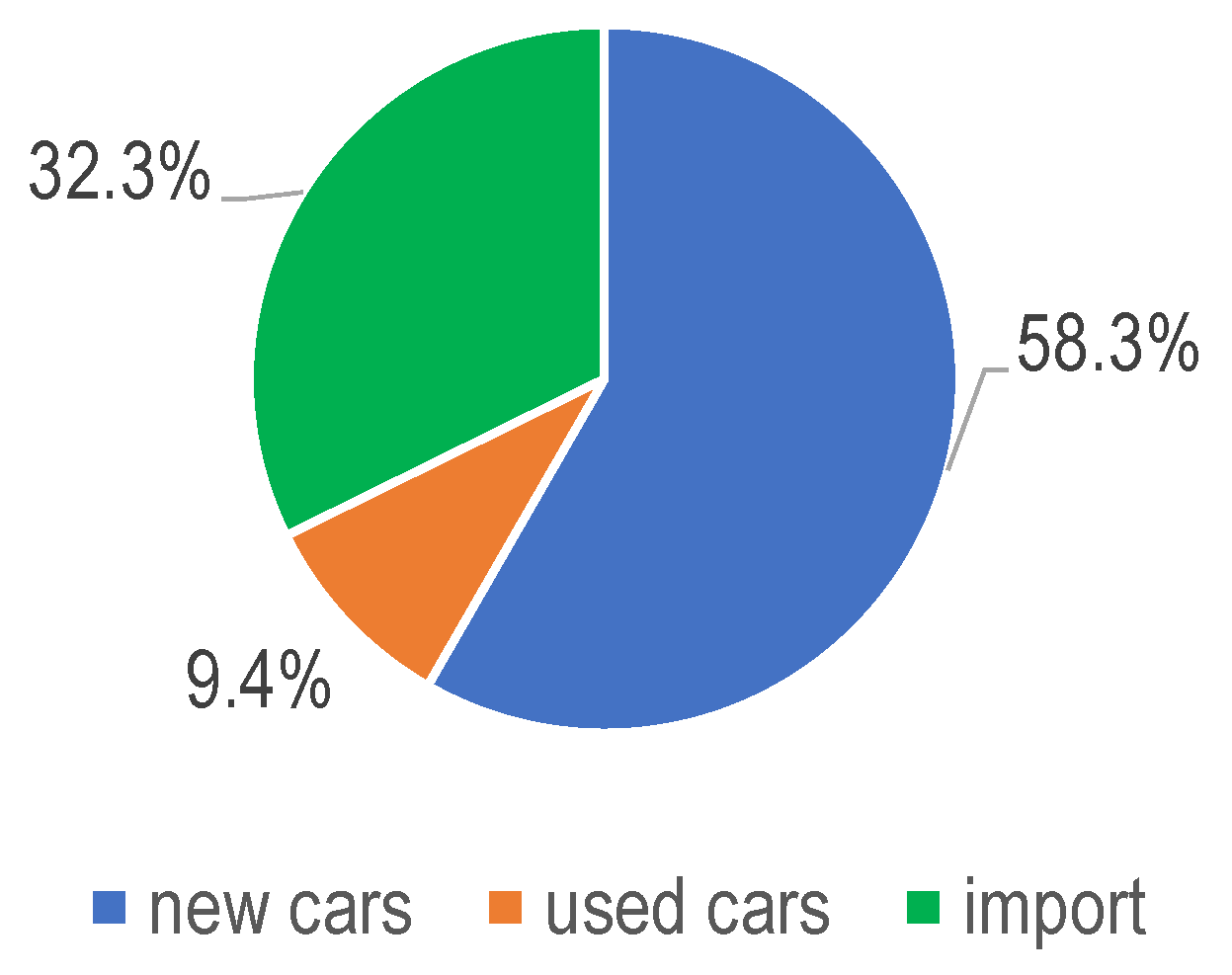
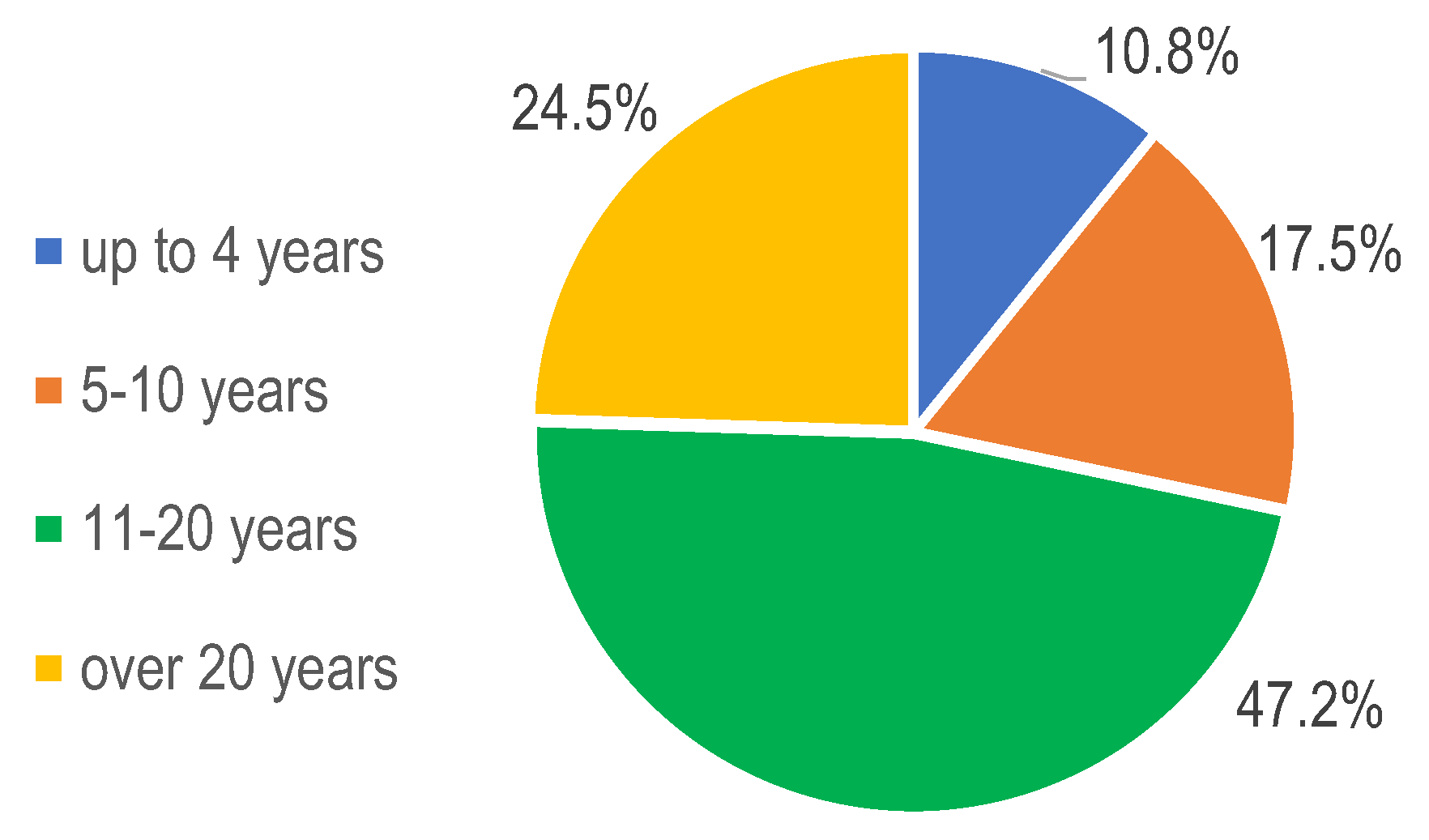




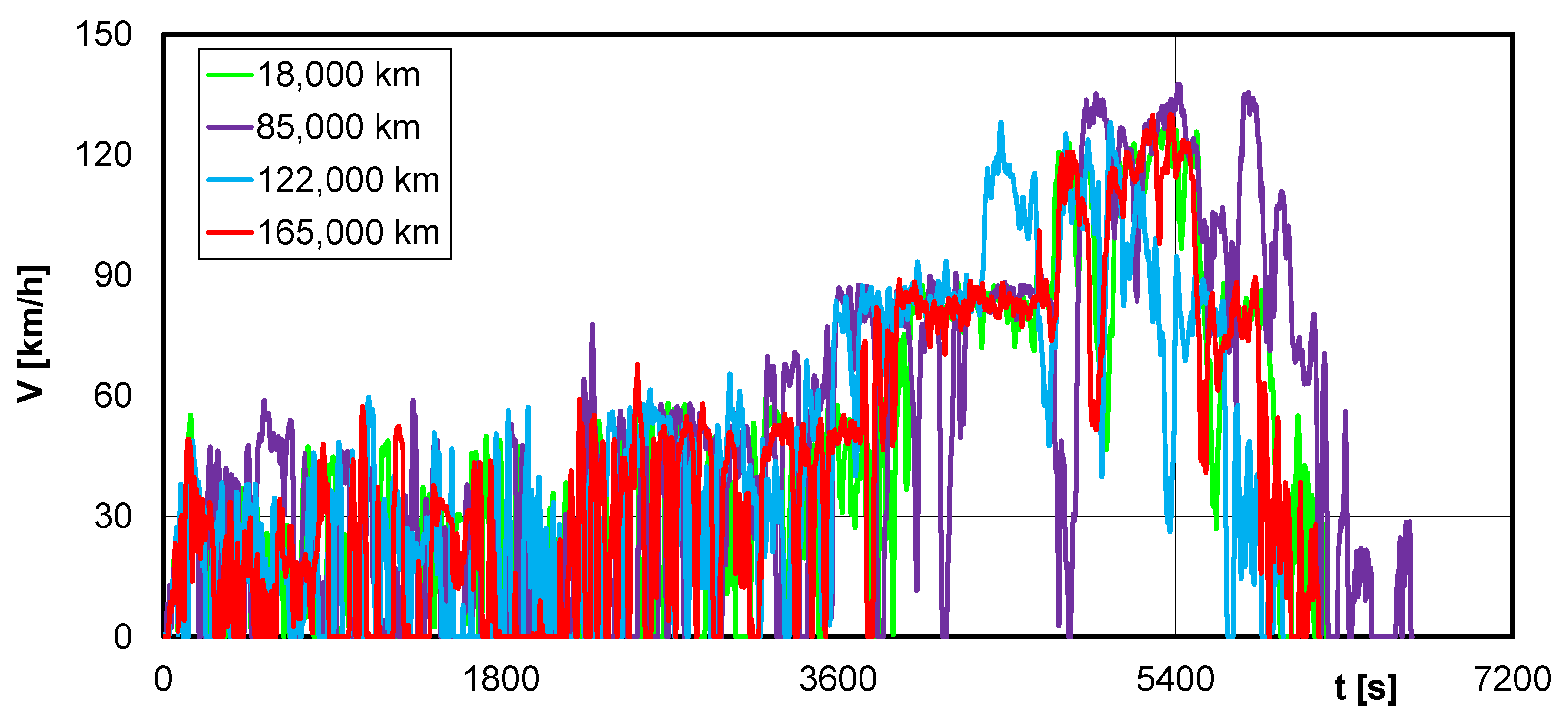




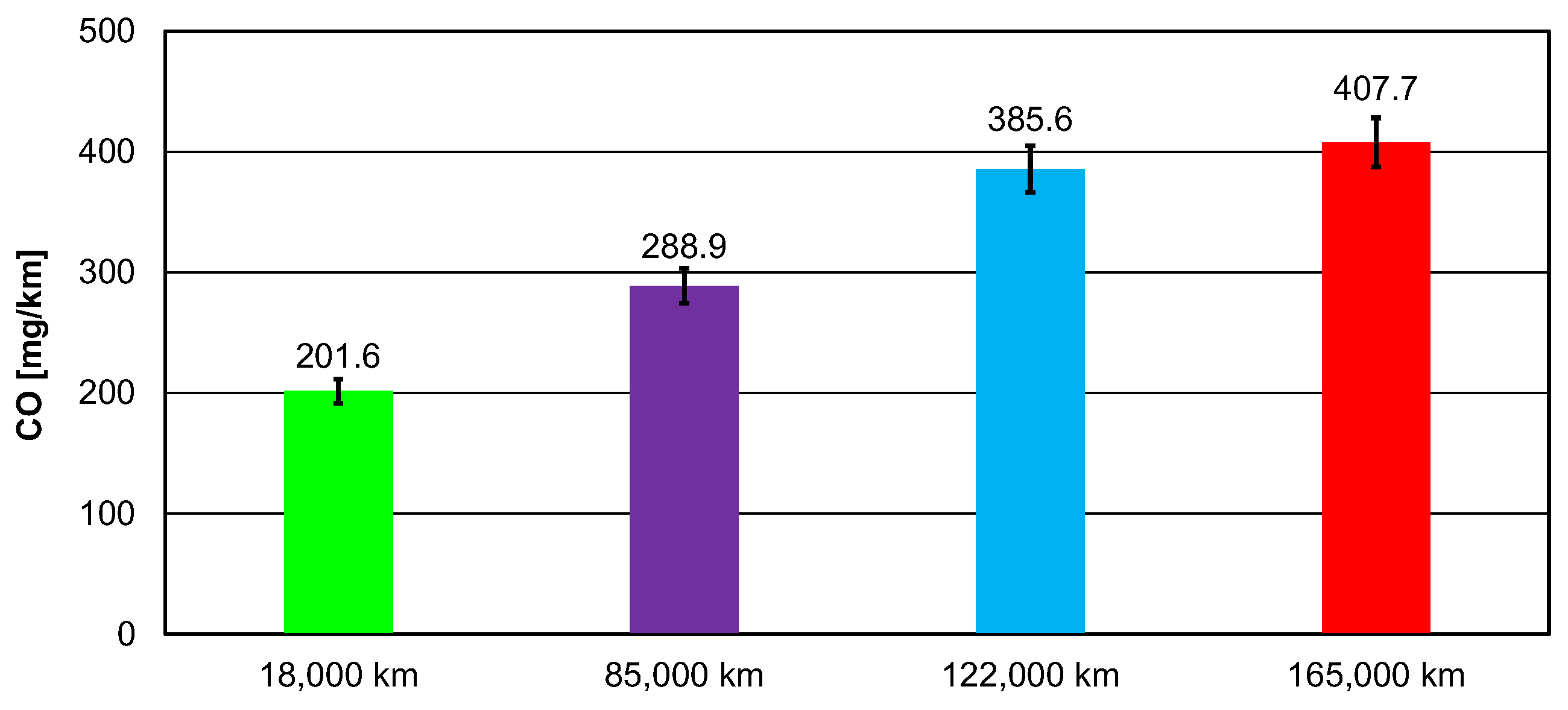

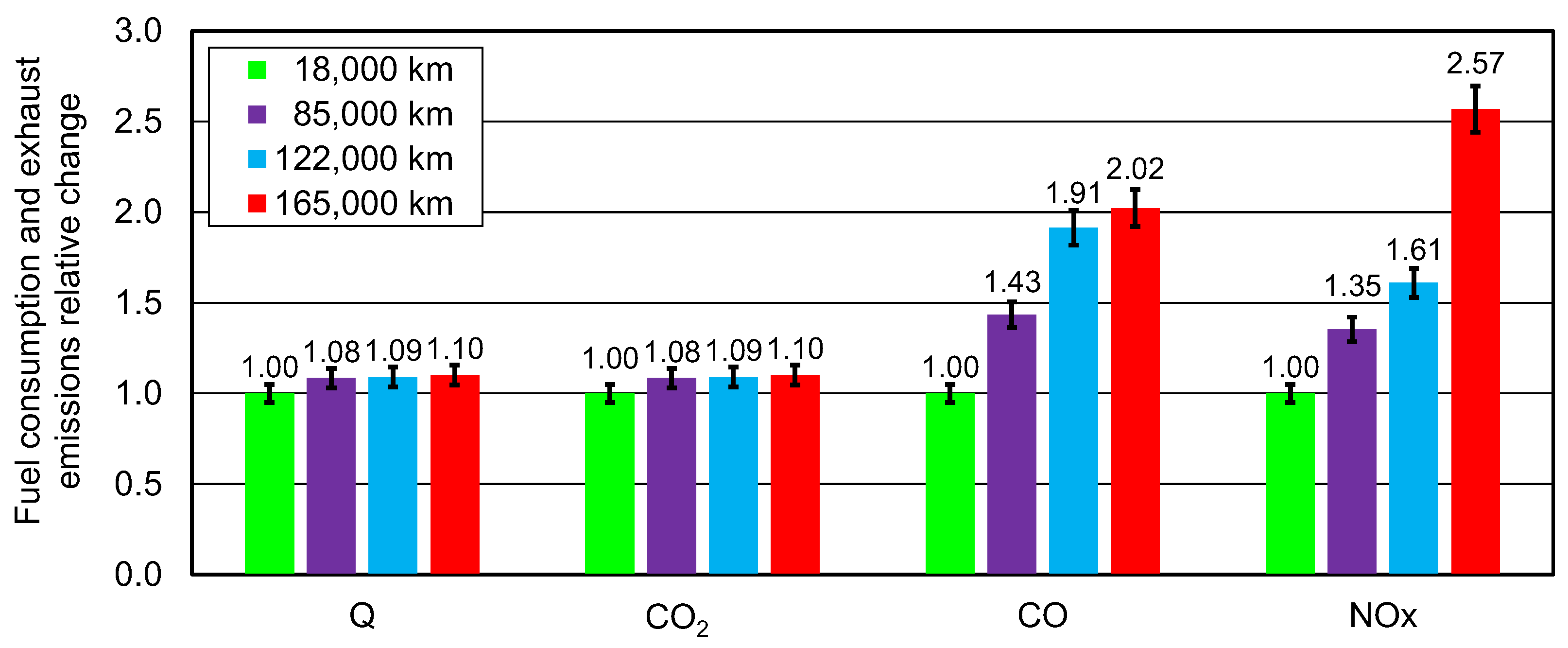
| Feature | WLTC | SRC | AMA | ARTEMIS |
|---|---|---|---|---|
| Application | Emission measurement in the type approval test | Accelerated ageing of exhaust gas treatment systems | Ageing cycle for determining emission deterioration factors | Exhaust gas emission assessment |
| Mapping traffic conditions | High | Low | Low | High |
| Heat load | Moderate | Significant (especially for a Diesel with DPF) | Low | Moderate |
| Current application | Type I approval test | Type V (durability, DF) | Unused (obsolete) | DPF durability |
| Measurement Feature | Measurement No. 1 | Measurement No. 2 | Measurement No. 3 | Measurement No. 4 |
|---|---|---|---|---|
| Vehicle mileage at time of measurement | 18,000 km | 85,000 km | 122,000 km | 165,000 km |
| Measurement date | 15 April 2017 | 11 March 2019 | 15 June 2022 | 1 August 2024 |
| Measurement duration | 103.3 min | 111.0 min | 99.2 min | 102.62 min |
| Distance travelled during measurement | 76.73 km | 91.16 km | 76.91 km | 77.12 km |
| Measurement location | Poznań and surroundings | Poznań and surroundings | Poznań and surroundings | Poznań and surroundings |
| Activities | RDE Test Vehicle Repairs | Date | Mileage |
|---|---|---|---|
| Type 1 | Oil change, oil filter, air filter, fuel filter, cabin filter replacement | October 2017 | 23,000 km |
| Type 1 | Oil change, oil filter, air filter, fuel filter, cabin filter replacement | October 2018 | 46,000 km |
| Type 1 | Oil change, oil filter, air filter, fuel filter, cabin filter replacement | October 2019 | 70,000 km |
| Type 1 | Oil change, oil filter, air filter, fuel filter, cabin filter replacement | October 2020 | 92,000 km |
| Type 1 | Oil change, oil filter, air filter, fuel filter, cabin filter replacement | October 2021 | 105,000 km |
| Type 1 | Oil change, oil filter, air filter, fuel filter, cabin filter replacement | August 2023 | 151,000 km |
| Type 1 | Oil change, oil filter, air filter, fuel filter, cabin filter replacement | August 2024 | 165,000 km |
| Type 2 | Replacement of brake pads and brake discs | October 2018 | 46,000 km |
| Type 2 | Replacement of brake pads and brake discs | October 2019 | 70,000 km |
| Type 2 | Replacement of brake pads and brake discs | October 2020 | 92,000 km |
| Type 2 | Replacement of brake pads and brake discs | October 2021 | 105,000 km |
| Type 2 | Replacement of brake pads and brake discs | August 2023 | 151,000 km |
| Type 2 | Replacement of brake pads and brake discs | August2024 | 165,000 km |
| Type 3 | Windscreen repair | November 2021 | 110,000 km |
| Type 4 | NOx sensor replacement | April 2022 | 118,000 km |
| Type 5 | Right drive shaft replacement | September 2024 | 170,000 km |
| Measurement Number | Measurement Date | Mileage [km] | CO2 Emission [g/km] | CO Emission [mg/km] | NOx Emission [mg/km] |
|---|---|---|---|---|---|
| Measurement 1 | 15 April 2017 | 18,000 | 196.97 | 201.56 | 66.90 |
| Measurement 2 | 11 March 2019 | 85,000 | 213.53 | 288.98 | 90.47 |
| Measurement 3 | 15 June 2022 | 122,000 | 214.74 | 385.65 | 107.72 |
| Measurement 4 | 1 August 2024 | 165,000 | 216.93 | 407.74 | 171.78 |
| Parameter | 18,000 km | 85,000 km | 122,000 km | 165,000 km |
|---|---|---|---|---|
| Urban (U) [km] | 27.69 | 25.91 | 25.65 | 26.61 |
| Rural (R) [km] | 28.98 | 31.80 | 27.20 | 29.04 |
| Motorway (M) [km] | 22.08 | 33.45 | 24.07 | 21.47 |
| Total trip [km] | 76.73 | 91.16 | 76.91 | 77.12 |
| Urban share [%] | 36.08 | 28.42 | 33.35 | 34.50 |
| Rural share [%] | 35.13 | 34.89 | 35.36 | 37.65 |
| Motorway share [%] | 28.78 | 36.69 | 31.29 | 27.84 |
| Urban: average speed [km/h] | 23.12 | 22.29 | 23.51 | 22.96 |
| Urban: stop share [%] | 28.39 | 28.90 | 23.43 | 28.31 |
| Average speed (cold phase) [km/h] | 20.93 | 19.18 | 20.01 | 21.45 |
| Max speed (cold phase) [km/h] | 55.19 | 47.30 | 48.75 | 49.24 |
| Stop time (cold phase) [s] | 42.00 | 33.00 | 66.00 | 45.00 |
| Time trip [min] | 103.30 | 111.00 | 99.17 | 102.62 |
| Test Phase | Mileage | CO2 [g/km] | CO [mg/km] | NOx [mg/km] | Q [L/100 km] |
|---|---|---|---|---|---|
| Urban | 18,000 km | 272.01 | 321.28 | 31.53 | 10.71 |
| 85,000 km | 336.50 | 1264.09 | 138.63 | 13.26 | |
| 122,000 km | 314.37 | 1135.42 | 133.79 | 12.39 | |
| 165,000 km | 319.90 | 979.95 | 135.12 | 12.61 | |
| Rural | 18,000 km | 143.79 | 185.34 | 45.06 | 5.65 |
| 85,000 km | 160.31 | 378.48 | 176.02 | 6.32 | |
| 122,000 km | 162.45 | 183.60 | 127.33 | 6.40 | |
| 165,000 km | 160.57 | 312.04 | 179.54 | 6.33 | |
| Motorway | 18,000 km | 167.79 | 71.28 | 137.90 | 6.61 |
| 85,000 km | 168.88 | 145.57 | 201.24 | 6.65 | |
| 122,000 km | 167.67 | 139.34 | 148.40 | 6.61 | |
| 165,000 km | 165.55 | 232.35 | 377.07 | 6.52 |
Disclaimer/Publisher’s Note: The statements, opinions and data contained in all publications are solely those of the individual author(s) and contributor(s) and not of MDPI and/or the editor(s). MDPI and/or the editor(s) disclaim responsibility for any injury to people or property resulting from any ideas, methods, instructions or products referred to in the content. |
© 2025 by the authors. Licensee MDPI, Basel, Switzerland. This article is an open access article distributed under the terms and conditions of the Creative Commons Attribution (CC BY) license (https://creativecommons.org/licenses/by/4.0/).
Share and Cite
Pielecha, J.; Pryciński, P. Deterioration of Exhaust Emissions in Ageing Gasoline Vehicles Assessed by RDE Testing. Energies 2025, 18, 5822. https://doi.org/10.3390/en18215822
Pielecha J, Pryciński P. Deterioration of Exhaust Emissions in Ageing Gasoline Vehicles Assessed by RDE Testing. Energies. 2025; 18(21):5822. https://doi.org/10.3390/en18215822
Chicago/Turabian StylePielecha, Jacek, and Piotr Pryciński. 2025. "Deterioration of Exhaust Emissions in Ageing Gasoline Vehicles Assessed by RDE Testing" Energies 18, no. 21: 5822. https://doi.org/10.3390/en18215822
APA StylePielecha, J., & Pryciński, P. (2025). Deterioration of Exhaust Emissions in Ageing Gasoline Vehicles Assessed by RDE Testing. Energies, 18(21), 5822. https://doi.org/10.3390/en18215822







